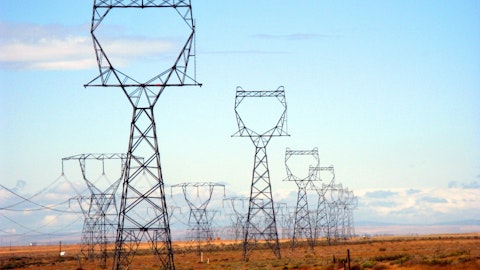Kevin Akers: Yes. I just want to reemphasize that the plan does reflect, as Chris said, they’re us becoming a tax cash payer out in that time frame. So that’s all backed into the plan that’s out there.
Operator: Your next question comes from the line of Julien Dumoulin-Smith of Bank of America.
Julien Dumoulin-Smith: Just maybe picking up where Gabe left off there. Just on the question of taxes, if you don’t mind. What about — for income statement purposes, how do you think about effective tax rate here? I mean, obviously, the comment is about going to a full cash taxpayer here in the next 3 years, certainly relevant from financing. But how do you think about the uptick, obviously, from ’23 to ’24, and then from there on out, in terms of the effective tax rate on the income statement. Obviously, I get that some of that over time is going to be subsumed back into the regulated cost structure. But I’m just curious on how you would set expectations and if there’s any kind of question about recovery and timing there, as well in the next few years as you see that uptick?
Christopher Forsythe: Yes. We’ll certainly see an uptick in the effective income tax rate. Again, that’s being influenced right now, certainly the last 2 or 3 years with these excess of deferred tax liabilities. Our effective tax rate 2 years ago was in the 11% range, it ticked up closer to 15%. And we’ll end up being in that 22% to 23% range here in the not-too-distant future. Again, all of these costs, we believe, are recoverable, including the IRA corporate minimum tax and our regulatory and tax teams are working on strategies right now to begin dialogue with those regulators to educate them on where that is in terms of what the law requires and then what the recoverability might look like.
Julien Dumoulin-Smith: Got it. Right. So regulatory strategy on the come here but not overly concerned about what that does in terms of, like maybe a lag headwind here in, call it, ’25 and ’26 as you kind of get to that more normalized level, if you will?
Christopher Forsythe: Yes, correct. Not material impact. And again, all that’s been reflected in the guidance for FY ’24 through to FY ’28.
Julien Dumoulin-Smith: Excellent. Very much appreciated. And then just on the O&M side, I just wanted to understand, as you think about that normalized, I think you said 3% to 3.5%. Like, how do you think about what is going on in the context of line locates within that composition through the future? I mean, obviously, that’s been elevated here. You saw a little bit of reprieve. How do you think about that contributing to that normalized level versus this just being the new norm? Or is there an elevated line locate just embedded in that 3 to 3.5 year?
Kevin Akers: Julien, it’s part of our ongoing strategy with whether they’re contractors or internal labor. We always look at what’s going on in the market where we have contracts as we look at those on an annual basis to see if they need adjustment, forecasted work for them, and any strategic opportunities we may have to in-source opportunities there to offset some of the cost taking a longer-term view. So all those options remain on the table as they have in the past, but we continue to look at these on an annual basis. So that’s where we get the comfort in that range that we put out there right now.
Julien Dumoulin-Smith: Okay. Fair enough. But it’s not like you have some meaningful further uptick in line locates or something like that, that we should be aware of here?
Kevin Akers: Now again, with the growth that I talked about on the front end and the population and trending that we’ve seen out there, that’s all been baked into the plan out there, all the labor or anticipated labor, the current contracts we have in place, the labor rates that are out there right now, we have baked all that into the plan.
Christopher Forsythe: Yes. And the 3.5% annual increase is off of FY ’23 levels kind of starting at that elevated level already.
Operator: Next question comes from the line of Ryan Levine of Citi.
Ryan Levine: I want to follow up on the O&M getting a little more granular. In terms of the outlook, it’s more on an annual basis. But can you speak to maybe the seasonality attributes of the O&M outlook. Should we look to — this most recent fiscal year as indicative of seasonality trends on a go-forward basis? Is there anything else to call out?
Christopher Forsythe: Yes, there’s that. On the O&M, there is some element of seasonality. It’s difficult to predict because we are managing our O&M over the entire fiscal year. So for example, like last fiscal year, where we had — at the start of the year, we had crews in place, kind of doing some in-line inspection work at APT at the end of fiscal ’22. It made good business sense to go ahead and continue that work into fiscal ’23, although it had been planned originally to be in the back end of fiscal ’23, rather than to demobilize the crews and remobilize 6 or 9 months later, we needed budget, we decided to go ahead and discontinue forward. So that was an operating decision that we made that we thought was in the best interest of the company and our customers.
And so we make those decisions on a day in and day out basis. So it’s difficult to predict. Certainly, those larger expenses when those could occur within a quarter. But certainly, we’re managing to our full fiscal year results. Same thing on line locates. Kevin talked about seeing some moderation right now that we’re seeing, but 6 months from now, we can be in a different environment and line locating may pick up for any number of reasons. And we, again, try to manage that on a full fiscal year basis. But quarter-by-quarter, we’re not as focused on how to get this work done in a quarter unless there’s a specific time requirement. But again, we are well ahead of our compliance deadlines which gives us the opportunity to manage from a full fiscal year basis.
Kevin Akers: Yes, Ryan, the other thing I’d say, Chris, is spot on with that is, we do — given the economic growth that we’ve seen across our service territory, there are times when jurisdictions would want to pull forward projects, whether they’re water, sewer related or there’s fiber things going on, fiber projects out there that we’ll have to move and adjust to as well based upon their time line. It may not be seasonably ratable, but it may be in a quarter it may show up. So again, we have to get the work done when we need to get the work done and work with our communities to make sure we’re in concert with their projects as well.
Ryan Levine: Great. And maybe just one other. In terms of within Texas with the Railroad Commission, is there any discussion around consolidating jurisdictions or regulatory constructs as you negotiate outcomes on a go-forward basis?
Christopher Forsythe: Yes. We’re aware of some filings that are out there kind of looking at that opportunity. We’re looking at those right now and seeing at that, would make — potentially makes sense for us. But we’re aware of what others are trying to do at this point in time.
Operator: There are no further questions at this time. I will now turn the call over to Dan Meziere for some closing remarks.
Daniel Meziere: We appreciate your interest in Atmos Energy, and thank you again for joining us this morning. A recording of this call is available for replay on our website through December 31. Have a great day.
Operator: This concludes today’s conference call. You may disconnect.



